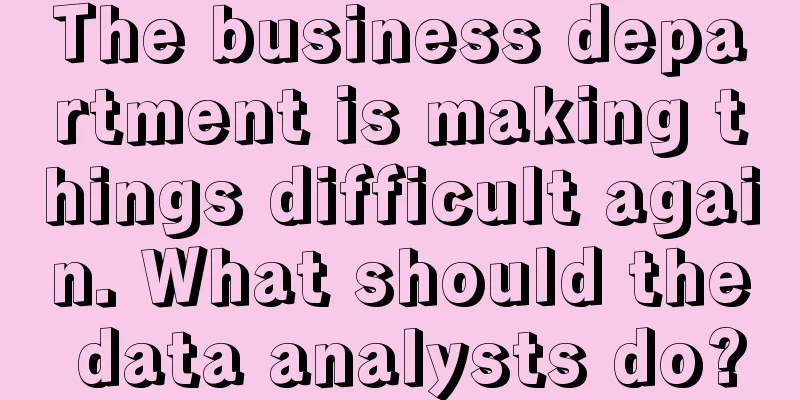The business department is making things difficult again. What should the data analysts do?

Students who work with data have a lot of inventory, summary, and review reports. A group of "brainless" teammates come online one after another, making it very difficult for students who do data analysis. For specific performance, see the following figure: Come, let me say the unspoken phrase for buying horses: Do business, do business, if you don’t even know what you want to do, what’s the point of doing it! Where is your brain? I didn’t know I should have asked earlier, but now it’s all done, I’ve pooped my pants, and I think of me when I wipe my butt... What should I do? Let’s go through it in detail today. 01 No brain? Either stupid or badWhy is this happening? One reason is: stupidity. Many people work without using their brains. It is true that many company operations, planners, and product managers just look for templates when doing their work, and copy competitors' products when they come up with creative ideas, and they don't know anything else. You ask him why he does it? He replied:
As for whether this would work, what the outcome would be, and what to do if it didn't work, I never thought about it at all. If the performance is good, then everyone is happy. If the performance is not good, then they start to blame the environment, the fierce competitors, the company’s lack of investment, and the leaders’ blind command. The last sentence: “This needs to be analyzed with artificial intelligence and big data”, has thrown the hot potato to them… There is another category: bad. I was afraid that I wouldn’t be able to complete the goals I wrote, so I deliberately left them blank, waiting for “artificial intelligence big data analysis.” It just so happened that the new guy believed it! He actually thought that the artificial intelligence model could handle it, and the two hit it off. Final result:
In short, these messes are what we don’t want to face. But if things have come to this point, and the teammates really have no goals, and their consciences are not bad, and they want to make amends together, what should we do? 02 The key to breaking the deadlock: finding a referenceIf you want to remedy the situation afterwards, the most important thing is to find a reference. Adding an evaluation standard after the fact. This is like "shooting the arrow first and then drawing the target", which is very unscientific. But it is better than having no evaluation standard. Because if there is no evaluation standard, simply calculating the performance, users, sales and other data in the activity will cause a series of problems: You see, it's totally unclear. This is still a performance-based activity. If it is a task-based activity, such as increasing the number of users or clearing inventory, it is even more confusing. How many users do you need to increase to be satisfied? What is the upper limit of growth? What will happen in the remaining months after all the money is spent? You have to clear the inventory anyway, so why do you say that your activity is good? Nothing is explained clearly. So remember: first find a reference, evaluate right and wrong, good and bad, then analyze why it is good/why it is bad, and how much room for improvement there is. This is the clearest and most efficient way to do it, and it can reduce a lot of meaningless wrangling. 03 Hidden Rigid TargetThis example is a promotion. Logically speaking, promotions will definitely boost sales, after all, they cost real money. The key question is whether the increased sales are worth the investment. This also means that promotional activities all have implicit rigid goals:
See the following figure for a specific example If you do an activity, it's worse than not doing it! There are not many people participating in the activity! Then it's a waste of time. What an obvious problem. BUT, usually at this time, the business department will come out to forcibly whitewash: "It's worse after the event because it would be even worse if we didn't do the event." This kind of whitewashing is shameless and a typical behavior of not admitting that something has gone wrong. Why don't you just say that the earth would explode if you didn't do the event? There are two situations at this time. If the trend is as in Figure 1 above, although the performance continues to decline, the decline is mild and the company can still make some progress at this time. If the trend is as in Figure 2 above, with normal cyclical fluctuations, but the performance dropped after the event, then the event was a bad one and there is no way to wash it off. At this time, the only thing I can say to the business side is: kneel down and admit your mistakes, and lower your head to get beaten. 04 Other ways to achieve goals afterwardsOf course, most promotional activities, after spending money, can still see some splashes, and indicators such as performance and users are still rising. At this time, other methods can be used to make up a goal afterwards. Specifically, it depends on the development and form of past activities. Situation 1: No past activitiesThis is common when an event is held for the first time, or when there has been no event for a long time. At this time, you can choose a time period of the same length as the event as a reference to see how much the event has increased overall. Then break it down to see the differences in the regions and user groups participating in the event. The business meaning behind doing this is: we take the overall level as a benchmark and see how to improve it to a level lower than the overall level. Through this comparison, points where optimization within the activity can be exposed. At the same time, since this is the first time, we will keep the overall level this time as a benchmark for the future so that we don’t have to worry about it next time. Case 2: No past activity and periodic fluctuationsBased on situation one, if the business affected by the activity itself has cyclical fluctuations (as shown in the figure above), then the activity may have a rising tide that lifts all boats. At this time, you can make a natural growth calculation based on the growth in the previous cycle, and then make an evaluation after deducting this part. Case 3: There was an event in the past, and only a single eventAt this time, you can use the last activity as a reference and first calculate the activity input-output ratio and the total effect. Combining these two indicators, you can determine whether continuing the activity will result in a loss or profit, and where the activity's influence limit can go. This way, you can characterize the activity: getting better/getting worse. With this judgment, you can look at how to improve the specific details later, and you will have a reference for detailed analysis. Case 4: There were activities in the past, and multiple activities overlappedAt this time, it is difficult to calculate the contribution of each activity (and because of this, many business parties give up setting goals, but they have to evaluate them separately later, which is annoying). The best way to deal with it is: first look at the overall input-output and set a general tone: the combination of activities in this period is high/low. With this tone, you can do a structural analysis later to see the impact of each small activity, so as to determine whether to add or delete many sub-activities. (As shown in the figure below) 05. Eliminate the need for post-event remediationComplaints aside, some business departments may really not know how to set goals...this is when you have to teach them seriously. Essentially, performance is achieved through action, not calculation. Setting goals in advance is only to motivate yourself to take action and achieve better results. What really requires complex analysis is the summary after the event, so there is no need for the business department to bear a lot of psychological pressure here. Having said that, if you don't perform well, you will be punished anyway, so why bother? 06 A special reminderThere is a type of goal that you should be particularly careful with, called "satisfaction." Generally, indicators like the number of users, number of paying users, sales, and sales revenue are all recorded by the system and have clear meanings, so it is totally fine to use them as goals. However, you should be especially careful with things like "satisfaction" that cannot be directly recorded and have unclear meanings. First of all, it is difficult to clearly define what satisfaction is. Are 5-star reviews considered satisfactory? Then do the reviews I bought with a 10-yuan coupon count as satisfactory? Do those who gave 5 stars and then complained count as satisfied? Do those who didn't leave a comment count as satisfied? Secondly, satisfaction is difficult to quantify using system data. Most issues are kept silent, so the system can only record extreme cases such as complaints and negative reviews. Most users do not have reliable system data. If you use sample questionnaires, you know the data quality... Again, satisfaction has no direct relationship with ultimate goals such as sales revenue and user volume. The more you criticize, the more popular you become. This is common in many industries. There are many indicators with unclear definitions, unstable data quality, and easy manipulation, such as: NPS, brand influence, brand reputation, market share (because industry data must be provided by third parties, you know what third parties are), etc. If the caliber is not clearly discussed beforehand, there will be endless wrangling afterwards. But the business side especially likes to write these words "attract new user registrations and enhance brand influence"... This is easy to say without any pain. It is recommended that those who have similar needs should ask colleagues in charge of market research or find a third party to do it. We will not wade into this muddy water. 07 The Ultimate SolutionThe ultimate solution is, of course, to have data analysts participate in the planning process and provide some professional guidance from the beginning to help everyone sort out their ideas. They can also share data on some failed projects in the past to improve the quality of planning. If you have the opportunity to attend the conference, you can confirm the event information according to the following script. If the business side says: There is no reference group, no reference period, and how to set it, then it would be best to ask the data analyst! We can provide professional advice based on actual conditions to save you the trouble. |
<<: List of 182 popular titles on Xiaohongshu.
>>: Instead of relying on low prices, Xiaohongshu's alternative "head anchor" rises
Recommend
There is a solution to the chaos of excessive filters in influencer marketing!
A proposal recently submitted by France requires i...
Does Lazada require a deposit? How much is the deposit?
Merchants who open online stores and operate store...
I have compiled 23 tips on how to use Xiaohongshu’s spotlight advertising!
In the ocean of digital marketing, Xiaohongshu'...
How is Wish's cross-border logistics calculated? What logistics can be sent?
Now, to register a store on the Wish platform, sel...
What are the cross-border e-commerce platforms available in China? How to choose a cross-border e-commerce platform?
With the continuous development of Internet techno...
How to find Shein's best-selling products? How to create best-selling products?
As a popular fashion e-commerce platform, Shein ha...
What does Amazon sp advertising mean? What are the functions of advertising?
The most common promotion method for Amazon mercha...
Alipay offers subsidies of over 10,000 yuan to recruit talents. Is it “taking advantage of traffic” or “new opportunity”?
Since 2022, the Alipay platform has started to upg...
Is it easy to build an independent website now? Is it still possible to build an independent website?
There is less competition on independent websites,...
How to register an Amazon US account? What are the conditions?
Many people go shopping on Amazon. When shopping, ...
Xiaohongshu e-commerce: Chaos in expansion
This article introduces the current status of Xiao...
2023 Revelation丨The Year of Virtual Humans
In 2023, the emergence of large models has given t...
Is the development prospect of Alibaba International Station account manager good?
Everyone is familiar with Alibaba. Taobao and Tmal...
Discover the hidden cards and give your brand new planning power!
This article mainly explains that planners should ...
What's the problem with Huaxizi?
Let's talk about brand and marketing separatel...









